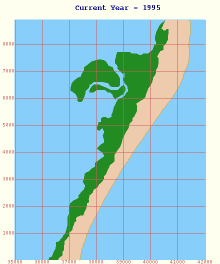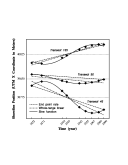Modeling of Shoreline Changes for Hog Barrier Islands of Virginia


Modeling of Shoreline Changes for Hog Barrier Islands of Virginia |
 
|
by
|
 ):
):
X = a*sin(b*T+c)+k (1) where, X is shoreline location on each transect (m); T is the time (year); a, b, c, and k are parameters.
The characteristics of shoreline changes on each transect are determined by the 4 parameters. The parameter a defines the amplitude of the sinusoid; b defines the period (the period is 2p/b); c and b define the phase (the phase is c/b); and k defines the axis location (Fig. 3). If the temporal scale is longer than centuries, the parameter k may be considered as a variable. For Hog Island, the period was treated the same for whole island. The values of the four parameters were determined with the numerical technique of the least-square method.
The values of the amplitude (a), and the phase (c/b) are different from south to north. The amplitude for the southern part of Hog Island is bigger than that for the northern part; the amplitude for either end of Hog Island is bigger than the middle of the island; the phase of the northern Hog Island delayed about a half of the period compared that with the southern part; the value of period was determined to be 190 years. The characteristics of these parameters lead to a clear dynamic shoreline change pattern: erosion occurs on the north when accretion occurs on the south, or in the reverse order. This kind of cyclic processes of shoreline changes may repeat very 190 years on Hog Island. Currently, the southern part of Hog Island just ended the erosion processes, while the northern part just ended the accretion processes.
The real shoreline on the demo means the shoreline that was calculated within the recorded 138 years time span; the predicted shoreline is the prediction beyond the time span.